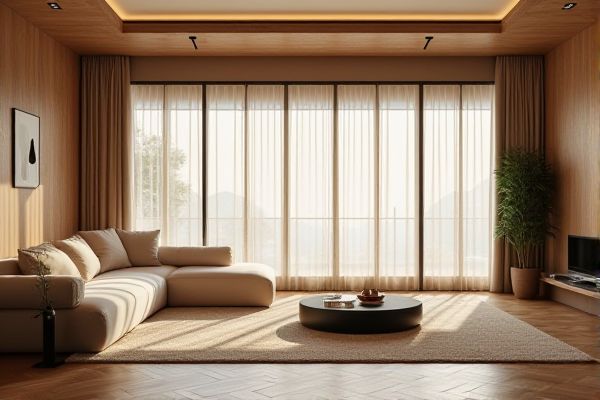
Folding screens offer flexible, portable partitions that can be easily adjusted and stored, ideal for temporary space division, while sliding room dividers provide a more permanent, space-saving solution by smoothly gliding along tracks for seamless room separation. Explore the advantages and use cases of each to determine which option best suits Your space and lifestyle needs.
Table of Comparison
| Feature | Folding Screen | Sliding Room Divider |
|---|---|---|
| Design | Multiple hinged panels, flexible folding | Fixed track system, panels slide horizontally |
| Installation | No installation needed, freestanding | Requires wall or ceiling track installation |
| Space Efficiency | Folds compactly, ideal for small spaces | Glides smoothly, saves floor space when open |
| Mobility | Highly portable and easy to move | Fixed to track, limited portability |
| Privacy | Moderate, depends on panel height and material | High, full coverage when closed |
| Customization | Variety of materials and decorative styles | Custom sizes and finishes, often more modern |
| Cost | Generally affordable and budget-friendly | Higher cost due to installation and materials |
| Use Cases | Temporary division, decorative enhancement | Permanent or semi-permanent room separation |
Introduction to Folding Screens and Sliding Room Dividers
Folding screens and sliding room dividers serve as versatile solutions to segment spaces while enhancing interior aesthetics. Folding screens consist of multiple hinged panels that can be easily moved or stored, offering flexible privacy and decorative appeal. Sliding room dividers operate on tracks, allowing smooth horizontal movement to partition areas efficiently without occupying additional floor space, making them ideal for your adaptable living or work environment.
Key Differences Between Folding Screens and Sliding Room Dividers
Folding screens consist of multiple hinged panels that allow flexibility in positioning and easy portability, while sliding room dividers operate on tracks for smooth horizontal movement and more permanent installation. Folding screens offer quick setup and versatility for small spaces, whereas sliding dividers provide a sleek, space-saving solution ideal for larger rooms and continuous partitioning. Your choice depends on whether you need temporary separation or a fixed, streamlined design for dividing areas effectively.
Design and Aesthetic Versatility
Folding screens offer intricate patterns and customizable panels that create a dynamic, movable focal point ideal for artistic and traditional spaces. Sliding room dividers provide sleek, contemporary lines and typically utilize glass or wood, seamlessly blending into modern interiors while maximizing space efficiency. Your choice between these options depends on whether you prioritize a bold, decorative partition or a minimalist, integrated solution.
Space-Saving and Flexibility Considerations
Folding screens offer exceptional space-saving benefits by easily collapsing flat when not in use, making them ideal for small rooms or temporary divisions. Sliding room dividers provide flexible, smooth movement along tracks, allowing precise control over the partitioned space without requiring additional floor area for storage. Both options optimize room functionality, but folding screens excel in compact storage while sliding dividers facilitate seamless spatial adjustments.
Installation and Maintenance Requirements
Folding screens require minimal installation, often being freestanding and easy to move, with maintenance limited to regular cleaning and occasional hinge lubrication to ensure smooth operation. Sliding room dividers demand more complex installation, typically involving tracks fixed to the ceiling or floor, which may require professional assistance for proper setup, and maintenance includes checking track alignment and cleaning to prevent debris buildup. Your choice depends on whether you value hassle-free setup and maintenance or a sleek, space-saving solution with more involved care.
Privacy and Sound Insulation Comparison
Folding screens offer moderate privacy with gaps between panels that may reduce sound insulation effectiveness, making them ideal for visual separation but less effective at noise control. Sliding room dividers provide a more solid barrier with tighter seals, enhancing both privacy and sound insulation by minimizing sound leakage. Your choice depends on whether visual separation or acoustic privacy is the priority in your space.
Material and Durability Options
Folding screens typically feature lightweight materials such as wood, fabric, or metal, offering portability but varying durability depending on the frame and panel thickness. Sliding room dividers often utilize sturdier materials like tempered glass, aluminum, or solid wood, designed for long-term use and frequent movement along tracks. Both options provide diverse finishes and customization, with sliding dividers generally providing superior durability for permanent or semi-permanent room separation.
Cost and Budget Factors
Folding screens generally offer a more budget-friendly option with prices ranging from $50 to $300 depending on materials and design complexity. Sliding room dividers tend to be more expensive, typically costing between $300 and $1,500 due to installation requirements and custom fitting. Consider long-term value and installation costs when budgeting, as sliding dividers may add higher upfront expenses but offer durability and space efficiency.
Ideal Use Cases for Folding Screens vs Sliding Dividers
Folding screens are ideal for temporary space division in small to medium-sized rooms, offering portability and easy storage, perfect for creating privacy in bedrooms or delineating workspaces in home offices. Sliding room dividers suit larger areas where a permanent or semi-permanent partition is needed, such as open-plan living rooms or conference rooms, providing smooth operation without taking up extra floor space. Both options enhance room functionality, but folding screens excel in flexibility while sliding dividers optimize space-saving and seamless integration.
Choosing the Right Room Divider for Your Space
Folding screens offer flexible, portable solutions ideal for temporary or frequently changing room configurations, while sliding room dividers provide a sleek, permanent partition that maximizes space without intruding. Your choice depends on your space's function, available floor area, and aesthetic preferences, with folding screens suited for smaller or multi-use rooms and sliding dividers perfect for modern, open-plan layouts. Evaluate the durability, installation requirements, and design style to select the most effective room divider for maintaining privacy and optimizing flow.
 homyna.com
homyna.com